Have you ever wondered why some birds have such long beaks? What purpose do these extraordinary features serve? In this article, we will take a closer look at 10 bird species that possess remarkable long beaks and delve into their fascinating characteristics. Get ready to be amazed by the beauty and functionality of these avian wonders.
Here are the main points:
- Long beaks in birds have evolved to suit specific ecological niches and provide various advantages.
- Birds with long beaks use them for feeding, courtship displays, and other unique behaviors.
- Species such as the sword-billed hummingbird, American white pelican, and toco toucan showcase the incredible diversity of bird beaks.
- Long-beaked birds have adapted to access specific food sources or engage in specialized feeding techniques.
- Each bird species with a long beak offers a captivating story of adaptation and survival.
Introduction to Birds with Long Beaks
Before we delve into the fascinating details of each bird species, let’s take a moment to appreciate the unique avian wonders that possess long beaks. These birds have evolved to adapt to their specific environments, utilizing their elongated bills in remarkable ways. From foraging for food to engaging in courtship rituals, their beaks play a vital role in their daily lives.
Long beaks enable these bird species to access food sources that may be out of reach for others. They have developed specialized beak shapes and sizes that allow them to extract nectar from deep flowers, catch fish with precision, or probe the ground for small invertebrates. Each bird’s long beak is a testament to the incredible diversity and adaptability of avian life.
The fascinating bird species we will explore in this article showcase the remarkable features and behaviors associated with their long beaks. Get ready to be captivated by their beauty, their unique feeding techniques, and their incredible adaptations to their respective habitats.
Sword-Billed Hummingbird
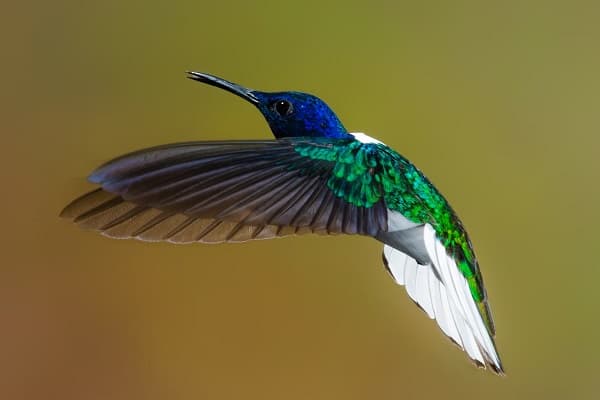
The sword-billed hummingbird is an extraordinary avian wonder with a beak that defies expectations. Among all bird species, it possesses the longest bill in proportion to its body size. This unique adaptation allows the sword-billed humming birds with long beaks to access nectar in flowers with long corollas that other hummingbirds can’t reach. Truly a fascinating sight to behold!
But the sword-billed hummingbird’s remarkable features don’t stop at its beak. It also boasts incredibly long legs that serve a dual purpose. These elongated limbs aid in perching, allowing the bird to find stability on slender branches while it feeds. Moreover, the long legs provide additional support for the hummingbird’s body weight, enabling it to sustain its energetic hovering capabilities.
When it comes to foraging, the sword-billed hummingbird’s long beak is a valuable tool. It is perfectly adapted to extract nectar from the specialized flowers it prefers. The bill’s length allows the hummingbird to reach deep within the corolla, where the sweet reward lies. This feeding strategy not only benefits the sword-billed hummingbird but also the plants it pollinates, creating a mutually beneficial relationship.
Observing the sword-billed hummingbird in action is a true marvel. Its vibrant colors, remarkable bill, and graceful movements make it a captivating sight for birdwatchers and nature enthusiasts alike. To witness this avian wonder in person is an experience that will leave you in awe of nature’s incredible diversity.
American White Pelican

The American white pelican, known for its distinctive long bill, is a magnificent aquatic bird that can be found in various regions of North America.
Unique Features
The most striking feature of the American white pelican is its long bill, which measures up to 18 inches in length. This long-billed species stands out among other pelican species, such as the brown pelican, which has a shorter and more robust bill.
The American white pelican’s long bill is its primary tool for feeding, allowing the bird to catch fish and scoop up aquatic invertebrates with precision.
With its bright yellow color and large throat pouch, the pelican’s bill is a standout feature that enhances the bird’s elegance and visual appeal.
Feeding Behaviors
The American white pelican employs a fascinating feeding technique known as plunge-diving. This involves soaring high above the water, locating its prey, and then rapidly descending into the water to catch fish. The bird submerges its head and bill underwater to scoop up its prey before resurfacing.
This plunge-diving behavior is a remarkable display of the pelican’s agility, precision, and mastery of the water.
The bird’s long bill is perfectly designed for this feeding technique, allowing it to reach deep into the water to catch its prey. This adaptation enables the American white pelican to thrive in its aquatic habitat.
Beautiful Plumage
In addition to its impressive bill and feeding behaviors, the American white pelican also boasts stunning white plumage. This bright and pristine coloration contrasts beautifully against the backdrop of water, creating a striking visual spectacle.
The pelican’s white plumage, combined with its large size and graceful flight, make it a captivating sight for birdwatchers and nature enthusiasts.
Whether seen soaring effortlessly in the sky or gliding gracefully on the water’s surface, the American white pelican is a true embodiment of natural beauty and resilience.
| Key Features | Details |
|---|---|
| Bird Species | American white pelican |
| Bill Length | Up to 18 inches |
| Feeding Technique | Plunge-diving |
| Behavior | Scooping up fish and aquatic invertebrates |
| Plumage | Stunning white coloration |
Long-Billed Curlew

The long-billed curlew, a magnificent shorebird species, boasts a distinctive and impressive feature – its long, curved beak. This remarkable adaptation enables the curlew to probe the ground for small invertebrates and other prey, essential for its survival and sustenance.
But the curlew’s beak is not only a utilitarian tool for feeding; it also plays a crucial role in the bird’s courtship rituals. During the breeding season, male curlews engage in elaborate displays to attract mates. Their courtship performances often involve aerial acrobatics and intense vocalizations, accompanied by the striking display of their long-billed beaks.
The male curlew birds with long beaks uses its beak to create resonant calls that can be heard from quite a distance, effectively signaling its presence and fitness to potential mates. The size and shape of the beak, combined with the bird’s elegant postures, become visual cues for attracting the attention of females.
In a mesmerizing dance, the male curlew gracefully lowers and lifts its long beak, showcasing its elongated appendage to its fullest extent. This display demonstrates not only the male’s physical prowess but also his ability to provide for the female and their future offspring.
As the courtship rituals unfold, the male curlew’s long-billed performances serve as a testament to his genetic superiority, ensuring successful mating opportunities and the continuation of this incredible shorebird species.
| Long-Billed Curlew | Key Characteristics |
|---|---|
| Scientific Name | Numenius americanus |
| Family | Scolopacidae |
| Habitat | Coastal areas, grasslands, and wetlands |
| Range | North America, from Alaska to Mexico |
| Diet | Insects, crustaceans, small invertebrates |
| Conservation Status | Near Threatened |
Roseate Spoonbill
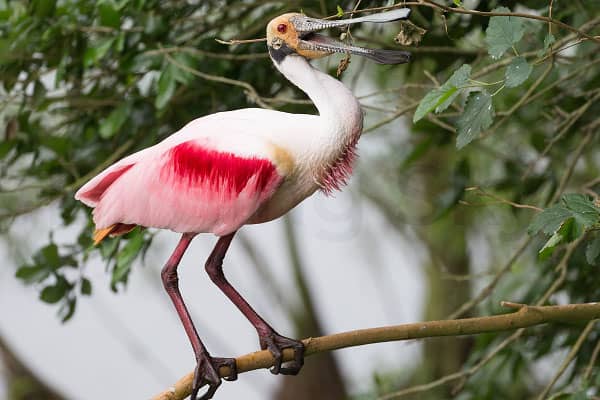
The roseate spoonbill, also known as the spoonbill, is a captivating wading bird that stands out with its distinct spoon-shaped bill. With its unique beak, the roseate spoonbill engages in fascinating feeding behavior, allowing it to feed on small aquatic creatures and probe the water for prey.
This beautiful bird’s elongated bill is a remarkable adaptation that aids in its foraging strategies. The spoon-like shape of the bill enables the spoonbill to sweep through shallow waters, sifting for food and capturing a wide variety of prey.
“The roseate spoonbill uses its long, slender bill to search for crustaceans, small fish, and aquatic insects within the mud and shallow waters.”
Its feeding behavior involves the extension of the spoonbill’s bill into the water, where it swings it from side to side, feeling for prey. Once it detects a potential meal, the spoonbill swiftly snaps its bill shut, capturing the creature with incredible precision.
In addition to its remarkable feeding behavior, the roseate spoonbill flaunts a stunning rose-colored plumage, making it a true spectacle to behold. This pink hue is the result of pigments found in its diet, which primarily consists of small crustaceans.
| Roseate Spoonbill Facts | Description |
|---|---|
| Scientific Name | Platalea ajaja |
| Habitat | Wetlands, marshes, and coastal areas |
| Range | Southern United States, Caribbean, Central and South America |
| Size | Approximately 28-38 inches (71-96 cm) in length |
| Diet | Crustaceans, small fish, and aquatic insects |
Toco Toucan
The toco toucan is widely recognized for its large, colorful beak. With a beak length of up to 8 inches, this bird’s remarkable feature is not only eye-catching but also serves various practical purposes. The toco toucan’s beak is long and lightweight, allowing it to access a wide variety of foods in its natural habitat.
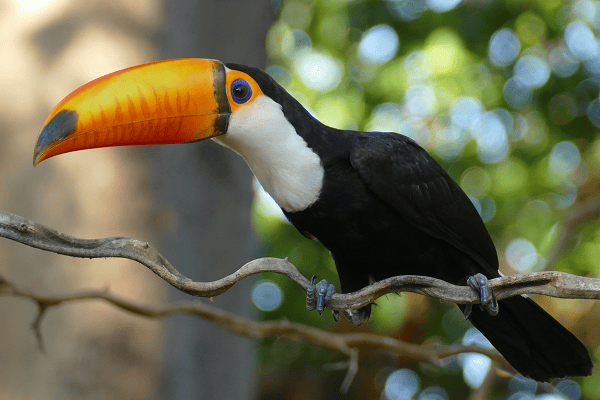
Primarily a frugivore, the toco toucan uses its beak to reach fruits that are otherwise inaccessible to smaller birds. The length and shape of its beak enable the toucan to pluck and consume fruits from tree branches with ease. The beak’s lightweight structure allows the toucan to balance its large size while navigating through the forest canopy.
But the toco toucan’s beak isn’t just limited to fruits. This charismatic bird has been observed catching small animals such as lizards, insects, and even small birds. Its long beak provides a strategic advantage when hunting, especially in situations where the toucan can surprise its prey with its swift movements.
In addition to its feeding habits, the toco toucan’s beak also plays an important role in seed dispersal. As the bird consumes fruits, it often swallows the seeds whole. The seeds then pass through the toucan’s digestive system and are excreted in different areas, contributing to the dispersal and regeneration of various plant species in its habitat.
Toco Toucan Behavior in the Wild
Living in the tropical rainforests of South America, the toco toucan is known for its social behavior. These birds often form small groups, flying and foraging together. Their vibrant beaks and distinct calls make them highly recognizable, and they play an important role in the ecosystem as seed dispersers.
The toco toucan’s beak is not only a functional tool but also a visual display. It has been suggested that the size and color of the beak may play a role in mate attraction and courtship rituals. Male toucans may use their beaks to engage in playful behavior, tossing and juggling fruits as part of their courtship displays.
“The toco toucan’s beak is a remarkable adaptation that showcases the diversity and ingenuity of nature. Its length and lightweight make it a versatile tool for feeding, hunting, and even seed dispersal. The beauty and functionality of the toco toucan’s beak truly highlight the wonders of avian evolution.” – Dr. Sarah Johnson, Avian Biologist
| Feature | Description |
|---|---|
| Beak Length | Up to 8 inches |
| Function | Accessing fruits, catching small animals, seed dispersal |
| Behavior | Foraging in groups, courtship displays |
Black Skimmer
The black skimmer is a fascinating bird species known for its unique feeding technique and distinctive features. With its specialized beak, the black skimmer has adapted to efficiently catch fish by skimming the water’s surface. Let’s explore more about this incredible bird and its remarkable characteristics.
One of the most notable characteristics of the black skimmer is its beak, which has a lower mandible longer than the upper mandible. This adaptation allows the skimmer to skim its beak through the water, detecting and catching fish swimming near the surface. The lower bill slices through the water, while the upper bill remains above, and when a fish is detected, the skimmer rapidly snaps its beak shut, capturing its prey.

In addition to its unique beak, the black skimmer also possesses black flight feathers. These dark feathers not only provide the skimmer with a sleek and elegant appearance but also play a vital role in its hunting strategy. By having black flight feathers, the skimmer can blend in with the dark waters, making it less visible to its unsuspecting prey.
The feeding technique of the black skimmer is a remarkable sight to witness. Flying just above the water’s surface, the skimmer’s lower beak dips into the water, creating a wake and ripples as it glides along. This feeding behavior is not only efficient but also allows the skimmer to minimize energy expenditure, making it an effective strategy for obtaining food.
To give you a better understanding of the unique beak and feeding technique of the black skimmer, here is a summary:
Black Skimmer Highlights
| Feature | Description |
|---|---|
| Beak | A lower mandible longer than the upper mandible, allowing the skimmer to skim its beak through the water to catch fish. |
| Flight Feathers | Black flight feathers that help the skimmer blend in with the dark waters, making it less visible to its prey. |
| Feeding Technique | Glide just above the water’s surface, dipping the lower beak into the water to create a wake and ripples, catching fish with minimal energy expenditure. |
The black skimmer is a true marvel of the avian world, showcasing exceptional adaptability and feeding strategies. Its unique beak and distinctive black flight feathers make it a captivating bird to observe in its natural habitat. Whether you’re a bird enthusiast or simply appreciate the wonders of nature, encountering a black skimmer is an experience you won’t soon forget.

Rhinoceros Hornbill
The rhinoceros hornbill is a magnificent bird known for its large beak with a distinct hook at the tip. This impressive feature sets it apart from other hornbill species and makes it easily recognizable.
Found in the dense rainforests of Southeast Asia, the rhinoceros hornbill showcases both impressive feeding habits and unique courtship rituals. Let’s explore these fascinating aspects of this forest-dwelling bird:
Feeding Habits
The rhinoceros hornbill’s large beak is not only a striking physical attribute but also serves a vital purpose in its daily life. The beak is highly efficient for foraging and capturing food.
The rhinoceros hornbill’s large beak is adapted to snatch and grasp a variety of prey, including fruits, small reptiles, mammals, and even other birds. It can easily crush the hard shells of nuts and fruits, enabling it to access a wide range of food sources.
This ingenious adaptation allows the bird to thrive in its rainforest habitat, where it plays a crucial role as a seed disperser. By consuming fruits and excreting seeds, the rhinoceros hornbill helps maintain the biodiversity of its ecosystem.
Courtship Rituals
One of the most captivating aspects of the rhinoceros hornbill’s behavior is its courtship rituals. Males engage in elaborate displays to attract females and secure their bond.
During courtship, male rhinoceros hornbills perform impressive aerial displays, showcasing their beautiful plumage and gliding skills. The large beak is prominently displayed, with the male striking it against nearby branches, creating a distinct sound that echoes through the forest.
This mesmerizing display not only demonstrates the male’s physical attributes but also serves as a means of communication with prospective mates.
Exploring the Fascinating Rhinoceros Hornbill
The rhinoceros hornbill is a remarkable bird species that captivates with its large beak, unique feeding habits, and courtship rituals. Understanding the intricacies of this beautiful bird enhances our knowledge of the diverse avian world and reminds us of the wonders found within nature.
Common Snipe
The common snipe is a slender shorebird known for its long and sensitive bill. With its remarkable elongated beak, the snipe is well-equipped to probe the ground in search of small invertebrates.

What makes the snipe’s bill unique is its ability to flex and open at the tip, allowing it to detect prey hidden beneath the surface. This specialized bill structure enables the snipe to extract its food source from mud or wet soil with precision.
Aside from its feeding habits, the common snipe also exhibits interesting breeding behavior. During the breeding season, male snipes perform aerial displays known as “winnowing.” They create a distinctive sound by diving in a display flight with their tail feathers spread, producing a unique sound effect caused by the wind rushing through their primary feathers.
Male snipes are known for their elaborate winnowing displays during courtship. The sound they produce is often described as a hauntingly beautiful and mesmerizing ‘chirr-r-r-r-r’ or ‘scaipe’.
These vocalizations play an essential role in attracting females and establishing territorial boundaries. The female snipe selects a mate based on the quality of the male’s winnowing display, with louder and more complex sounds indicating vigor and fitness.
Summary:
In summary, the common snipe birds with long beaks is a fascinating shorebird with a long bill adapted for probing the ground and finding prey. Its elongated beak, along with its unique breeding behavior and vocalizations, make the common snipe a captivating bird species to observe.
Avocet
The avocet is a fascinating bird species with a long curved beak that sets it apart from other avian creatures. Its elegant upwardly curved bill serves a specific purpose – to probe and feed on small aquatic invertebrates.
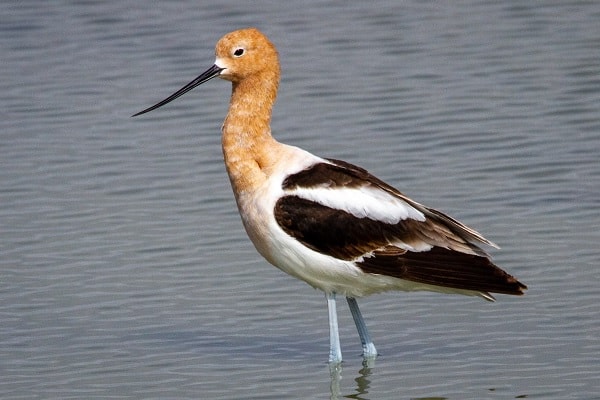
This unique feeding strategy allows the avocet to forage in shallow waters, where it deftly sweeps its beak from side to side, searching for food. The long curved beak acts as a precise tool, enabling the bird to navigate through mud and sediment to capture insects, crustaceans, and various aquatic organisms.
Besides its remarkable feeding strategy, the avocet is also known for its striking black-and-white plumage. The contrast between these two colors creates a visually stunning appearance, adding to the bird’s allure.
The avocet birds with long beaks can be found in a variety of habitats, including coastal marshes, estuaries, and lagoons. Its adaptability to different environments allows it to thrive in diverse ecosystems around the world.
Marabou Stork
The marabou stork is a fascinating birds species with long beaks known for its impressive size and distinctive features. One of its most prominent characteristics is its large beak, which plays a crucial role in its feeding habits. This impressive beak enables the marabou stork to catch various small animals, including fish, with remarkable precision.
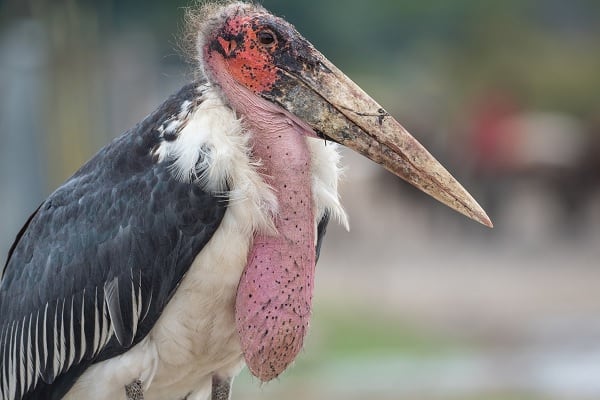
Not only does the marabou stork’s beak serve as a formidable tool for hunting, but it also contributes to the bird’s striking appearance. The beak is long, thick, and slightly curved, perfectly suited to the stork’s feeding needs. Its impressive size, combined with its sharp and pointed tip, make it a formidable instrument in the stork’s search for food.
The marabou stork is most commonly found in wet habitats, such as rivers, lakes, and marshes. These regions offer ample opportunities for the stork to find its preferred diet of small aquatic animals. However, it is worth noting that the marabou stork is also known to scavenge and feed on carrion, showcasing its adaptability and opportunistic feeding habits.
FAQs About Birds with Long Beaks
Q1: What type of bird has a very long beak?
The ibis is a bird known for having a very long beak.
Q2: What is a small GREY bird with a long beak?
The hermit thrush is a small grey bird with a long beak.
Q3: What is a water bird with a long beak?
The egret is a water bird that typically has a long beak.
Q4: What is the name of a bird’s beak?
A bird’s beak is commonly referred to as its bill.
Q5: Why does my bird have a long beak?
Birds often have long beaks adapted to their specific feeding habits and environmental needs.
Q6: What is the smallest bird with a long beak?
The hummingbird is one of the smallest birds with a relatively long beak compared to its body size.
